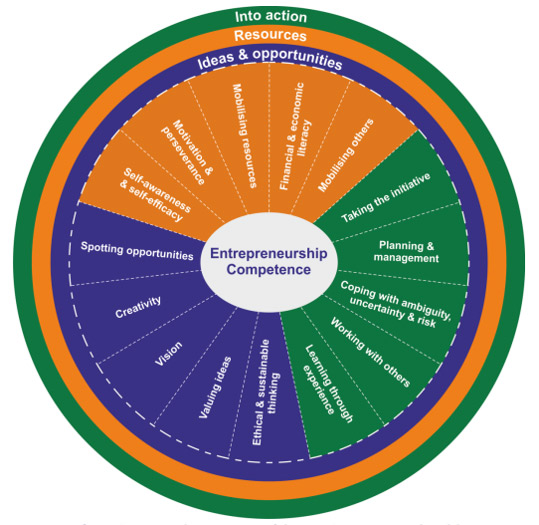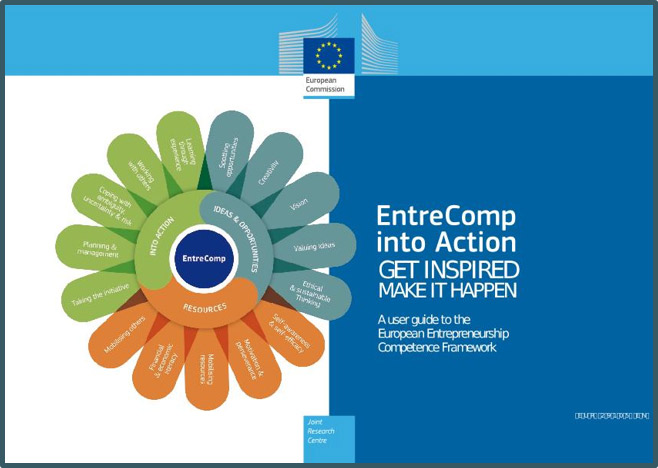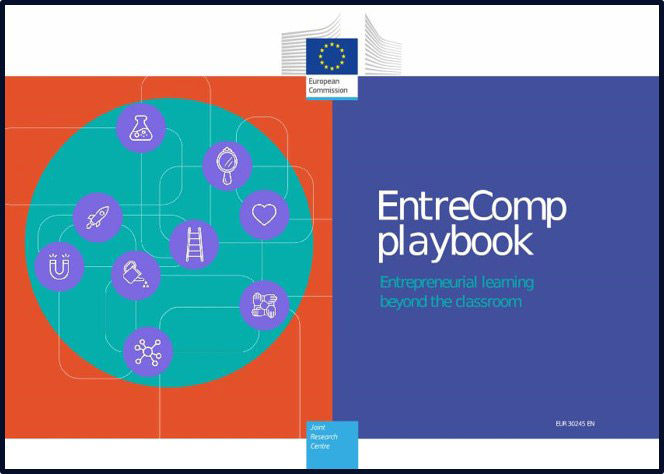|
Introducing the Entrepreneurial competence framework EntreComp – scale and scopeClick to read
 The European framework of EntrepreneurshipThe EntreComp Framework consists of 15 entrepreneurial competences distributed among three key focus areas (Ideas and Opportunities, Resources and Into Action) that are conceived as the “essentials” of entrepreneurial attitudes and sense of initiative. The EntreComp stems from major long-standing policy priorities of EU institutions aimed at boosting the attractiveness of entrepreneurship as career path for all Europeans and strengthening the entrepreneurial competitiveness of organisations. Due to its impact at EU level both in the domain of education and employment, the EntreComp is the largest international effort to build consensus on what it takes to “be entrepreneurial”.
Each of the 15 competences (i.e., the building blocks of entrepreneurship) progress along a 8-layer proficiency model. By combining competences’ threads (i.e., sub-competences – 60 in total) to each of the proficiency level, the final output results in a matrix of 442 learning outcomes. The framework has been conceived as a concrete tool to help professionals, coaches and teachers in better designing training programmes and education initiatives focused on nurturing entrepreneurial spirits and sense of initiative.
EntreComp: competence areas and competencesClick to read

The 15 “building blocks” are distributed in groups of five per each training area. With that said, if an entrepreneurial attitude revolves around this 15 competences, entrepreneurs and business owners can readapt and apply the same framework to each of business’ critical functions. For established entrepreneurs, the EntreComp can be a useful resource to reignite and boost their sense of initiative, creative thinking and innovation upon their current and consolidated operational framework. In other words, a source of inspiration for new ideas and new ways of doing things…
EntreComp and its implications for cybersecurity…as such, entrepreneurs and business owners can transit on the 8-level progression model to test their full embracement of cybersecurity as a permeating resource for their competitive advantage:
Source: EntreComp Progression model, pp. 16 EntreComp for (cyber) risk management Competence 3.3Click to read
 If we look at the third pillar of EntreComp, competence 3.3 addresses “Coping with uncertainty, ambiguity and risk”
Based on the formal explanation of the competence, risk management’s pillars relies on a balanced combination of: • Resilience attitude
• Trial-and-error approach
• Learning by experience (and by doing)
• Scenario making
• Forecasting
•Problem solving
Threads of competence 3.3Click to read
 Each EntreComp’s competence is brokendown in a series of sub-competences (i.e. Threads) to allow for a more deepen and detailed understanding of the reference competence. In the case of 3.3, these sub-competences are: • Cope with ambiguity and uncertainty
• Calculate risk
• Manage risk
Relevant to mention is the fact that EntreComp’s risk label apply to all sorts of functional, operative and technical risks that some might face in business, including cyber risk… Cope with ambiguity and uncertaintyClick to read
 By training their mind to cope with ambiguity and uncertainty, entrepreneurs develop a renewed mindset that supports them in being more “sophisticatedly cautious” in planning and executing their strategies. Ambiguity and uncertainty are intrinsic elements of entrepreneurship, being able to cohabit with them is an entrepreneurial soft skill as much as leadership, people management, public speaking, etc.
Source: EntreComp into Action – pp. 200
Calculate riskClick to read
 Calculating risk(s) translates into being fully aware of how external threads and internal weaknesses might disrupt organisation and people’s efficiency/effectiveness. When entrepreneurs feel “comfortable” in ambiguity and risk – meaning, when they understand and accept them as part of the equation and not necessarily a source of stress – they are much more aware of the surroundings and of their decision making. In the second training module, IDP provides for several frameworks/reference models to be better equipped in assessing and evaluating (cyber) risks.
Calculate risk – a progression model
Source: EntreComp into Action – pp. 200 Manage riskClick to read
 Cyber-aware entrepreneurs make of risk management an ongoing, transversal, horizontal activity, not only for the efficiency, effectiveness and safeguard of their IT systems, but most importantly, for the overall (digital) performance of their businesses. Managing risk(s) is relatively easy if one knows first: • Which are the risks at highest disrupting impact for his/her organisation • What’s their likelihood to happen in a given period of time
• Possible countermeasures in case Plan B might fails
Manage risk – a progression model
Source: EntreComp into Action – pp. 200 Resources for EntreComp’s implementation EntreComp’s official follow-upClick to read
 Since its formal publication (2016), the EntreComp has been applied in many diverse domains of societies: industry and private sector, formal and non-formal education, etc. The model is extremely versatile by design and it found great consensus in both educational and private sector’ settings. Best practices for its implementation in real-life settings have been gathered and collected by the European Commission in the course of more recent years. These case studies are available through two different resources (following slides) EntreComp into Action – Get inspired, make it happenClick to read

EntreComp at WorkClick to read

EntreComp PlaybookClick to read

Key takeawaysClick to read
 • EntreComp as the reference framework for education and training on entrepreneurial attitudes and sense of initiative
• Three pillars (i.e. Training Areas) → 15 Competences → 60 sub-competences
• 8-dimension progression model → 442 Learning Outcomes
• “Copying with ambiguity, uncertainty and risk”, competence 3.3.
| ||||||||||||||||||||||||||||||||||||||||||||||||||||||||||||||||||||||||||||||||||||||||||||||||||||||||||||||||||||||||||||||||||||||||||||
Keywords
EntreComp, entrepreneurship, sense of initiative, risk management, uncertainty, ambiguity, calculating risk
Objectives/goals:For established entrepreneurs, the EntreComp can be a useful resource to reignite and boost their sense of initiative, creative thinking and innovation upon their current and consolidated operational framework.
In the context of this training module, readers will be introduced to the EntreComp Framework and how it can be of relevance for cyber security and IT proficiency.
Specifically, the EntreComp Framework will be our reference model to help targets in being more responsive and alert to cyber threats, enhancing their awareness of cyber-hygiene and being overall more competitive in all domains of business.
Related training material


 Play Audio
Play Audio 



 Cyber risk is one of the many ambiguities and uncertainties navigated by 21
Cyber risk is one of the many ambiguities and uncertainties navigated by 21












